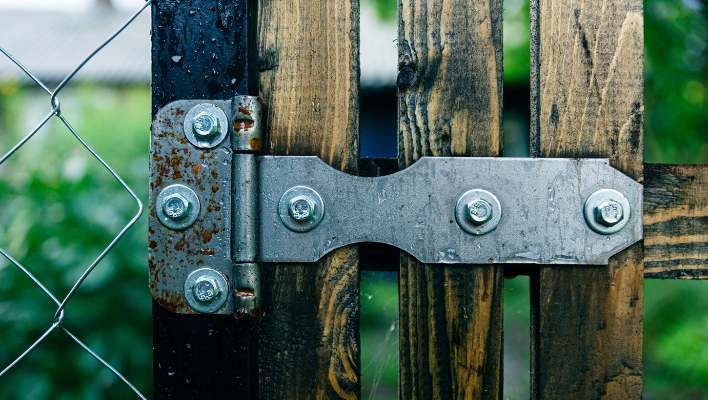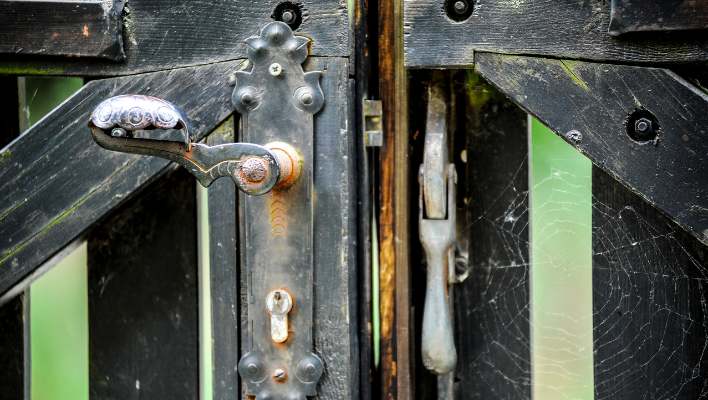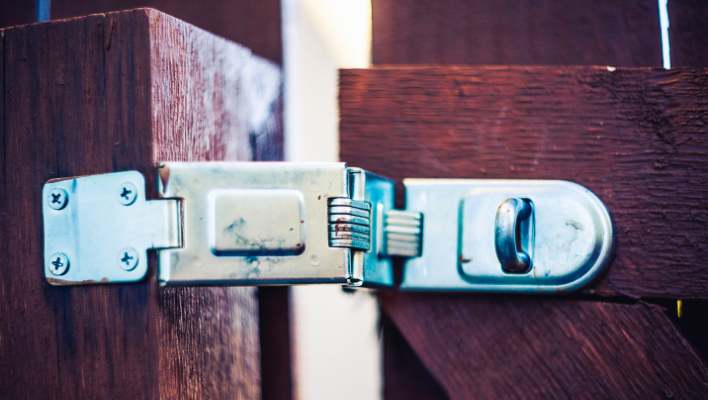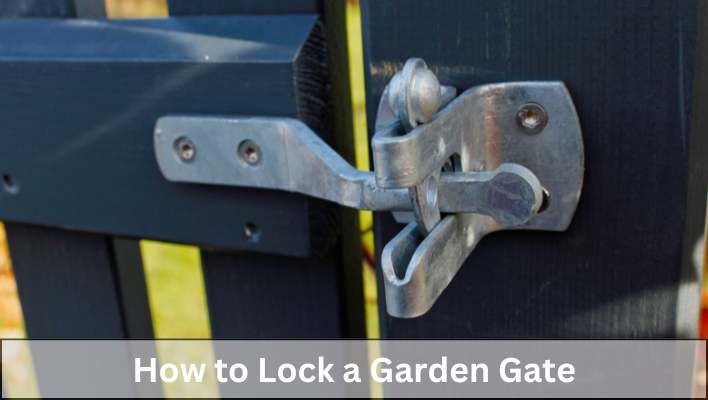To lock a garden gate, simply install a sturdy padlock on the latch. Here’s how you can secure your garden gate with a lock, ensuring the safety and privacy of your outdoor space.
With the growing importance of security, it is essential to keep your garden gate properly locked. A locked gate not only deters potential intruders but also prevents pets or children from wandering outside unattended. By following a few simple steps, you can ensure that your garden gate remains securely locked at all times.
We will guide you through the process of locking a garden gate effectively, providing you with peace of mind and added security.
Table of Contents
- Understanding The Importance Of Garden Gate Security
- Assessing Your Garden Gate Locking Needs
- Step-by-step Guide: Installing A Lock On Your Garden Gate
- Additional Security Measures For Garden Gates
- Maintenance And Care For Garden Gate Locks
- Frequently Asked Questions Of How To Lock A Garden Gate
- Conclusion
Understanding The Importance Of Garden Gate Security
Garden gate security is of utmost importance for ensuring the safety and privacy of your property. Discover effective ways to lock your garden gate and protect your outdoor space.

Why Securing Your Garden Gate Is Crucial
Securing your garden gate is of utmost importance to ensure the safety and privacy of your property. A well-protected garden gate serves as a deterrent to potential intruders, keeping your garden and the belongings within it safe from theft and vandalism. By taking the necessary steps to ensure your garden gate is properly secured, you can have peace of mind knowing that your outdoor space is adequately protected.
The Potential Risks Of An Unsecured Garden Gate
An unsecured garden gate poses significant risks that can compromise the safety and security of your property. Without proper protection, unauthorized individuals may easily gain access to your garden, increasing the likelihood of theft, vandalism, and unauthorized entry into your home. Additionally, a visibly unsecured gate may invite unwanted visitors onto your property, jeopardizing the privacy and tranquility of your outdoor space.
Read Also: How to Measure Garden Hose Diameter
Highlighting The Need For Reliable Locking Mechanisms
One of the key elements of securing your garden gate is ensuring that it has a reliable locking mechanism in place. A sturdy lock not only keeps intruders out but also provides a visual deterrent, letting potential trespassers know that your property is well protected. Investing in a high-quality lock specifically designed for garden gates is essential for maintaining the security and integrity of your outdoor space.
When it comes to choosing a locking mechanism, there are several options available to suit the unique needs of your garden gate. Consider factors such as convenience, durability, and level of security offered. Some popular options include padlocks, combination locks, mortise locks, and keyless locks. It is crucial to select a lock that offers both reliability and convenience, ensuring that you can easily secure and access your garden gate when needed.
In addition to a secure lock, it is also essential to regularly inspect and maintain your garden gate. This includes checking for any signs of wear or damage, such as loose hinges, weak joints, or rusted components. By promptly addressing any issues, you can prevent potential vulnerabilities and prolong the lifespan of your gate, thereby enhancing its overall security.
By understanding the importance of garden gate security and taking the necessary precautions, you can keep your outdoor space safe, secure, and free from unwanted intrusions. Prioritizing the protection of your garden gate ensures that you can enjoy your outdoor sanctuary, knowing that your property and belongings are safeguarded.
Assessing Your Garden Gate Locking Needs
Choosing the right lock for your garden gate is not a decision to be taken lightly. Assessing your garden gate locking needs is an important first step in securing your garden and keeping unwanted visitors out. Whether you are looking for increased security, ease of use, or a combination of both, considering the factors involved and understanding the different types of locks available will help you make an informed decision.

Factors To Consider When Choosing A Garden Gate Lock
When it comes to selecting a garden gate lock, there are several factors to consider. The first factor is the level of security you require. Do you need a lock that is resistant to picking, cutting, or tampering? Additionally, think about the location of your gate and the level of foot traffic it receives. A lock that is durable and weather-resistant is essential for gates exposed to the elements. Consider the material and weight of your gate as well. Some locks are better suited for lightweight wooden gates, while others are specifically designed for heavier metal or wrought iron gates.
Another important factor to consider is the ease of use. Do you want a lock that requires a key, a combination, or a keypad entry system? Think about the convenience factor and who will be using the lock. For instance, if you have children who frequently access the garden, a lock that requires a key may not be the most suitable option. Lastly, consider your budget. Garden gate locks come in a range of prices, and it’s important to find one that meets your needs without breaking the bank.
Read Also: How to Remove Garden Hose Connector
The Different Types Of Locks Available For Garden Gates
Now that you have assessed your garden gate locking needs, it’s time to explore the different types of locks available. Below, we discuss three common types:
- Padlocks: Padlocks are versatile and commonly used for garden gates. They come in various sizes and are often made of robust materials like stainless steel or hardened steel. Padlocks can be key-operated or combination-operated, providing options based on your preference for locking mechanisms.
- Mortise locks: Mortise locks are popular for wooden garden gates and offer excellent security. They are embedded within the gate and require a key to lock and unlock. Mortise locks are known for their durability and resistance against forced entry.
- Gate latch locks: Gate latch locks are a convenient option for garden gates that do not require high-level security. They are usually operated with a latch or bolt mechanism and can be opened and closed easily. Gate latch locks are commonly used for decorative or light-duty gates.
Selecting The Most Suitable Lock For Your Specific Gate
Now that you are aware of the factors to consider and the different types of locks available, it’s time to select the most suitable lock for your specific gate. Consider the requirements you identified during the assessment phase and match them to the lock options available. Look for a lock that fulfills your security needs, is compatible with your gate material and weight, and aligns with your desired level of convenience and budget. By taking the time to evaluate your specific needs, you can ensure that your garden gate remains securely locked while providing peace of mind.
Step-by-step Guide: Installing A Lock On Your Garden Gate
Securing your garden gate is crucial in maintaining the privacy and security of your outdoor space. Whether you want to keep out unwanted visitors or ensure your pets and children stay safe, installing a lock on your garden gate is a simple and effective solution. In this step-by-step guide, we will walk you through the process of installing a lock on your garden gate, from gathering the necessary tools and materials to adjusting and testing the lock for proper functionality.
Gathering The Necessary Tools And Materials
Before you begin the installation process, it is important to gather all the necessary tools and materials. Here’s a list to make sure you’re prepared:
- Power drill
- Measuring tape
- Phillips screwdriver
- Adjustable wrench
- Pencil
- Level
- New lock mechanism
- Screws
Removing The Existing Lock (if Applicable)
If your garden gate already has a lock installed, you will need to remove it before you can install the new one. Follow these steps to remove the existing lock:
- Use the phillips screwdriver to unscrew and remove any screws holding the lock in place.
- Once the screws are removed, gently pull the lock mechanism away from the gate.
- Inspect the area to ensure there are no remaining screws or pieces of the old lock.
Installing The Chosen Lock Mechanism
Now that you have removed the existing lock, or if you didn’t have one to begin with, it’s time to install the new lock mechanism. Follow these steps:
- Hold the lock mechanism against the gate and use a pencil to mark the placement of the screw holes.
- Use a power drill to create pilot holes at the marked locations.
- Position the lock mechanism back against the gate and secure it in place using screws.
- Make sure the lock is level by using a level or by eye.
Adjusting And Testing The Lock For Proper Functionality
With the lock mechanism now installed, it’s time to adjust and test its functionality. Follow these steps:
- If the lock is not aligning properly or smoothly, use an adjustable wrench to loosen the screws and adjust the position of the mechanism.
- Once the lock is aligned properly, tighten the screws to secure the mechanism in place.
- Test the lock by opening and closing the gate multiple times to ensure it engages and disengages smoothly.
- If any adjustments are needed, repeat the above steps until the lock operates smoothly and securely.
Additional Security Measures For Garden Gates

When it comes to safeguarding your garden and ensuring your peace of mind, it’s crucial to implement additional security measures for your garden gate. By taking the necessary steps to reinforce the gate structure, utilizing supportive devices such as gate braces, and installing surveillance cameras for monitoring, you can significantly enhance the security of your garden. In this article, we will explore these measures in detail, providing you with practical tips and insights to effectively lock your garden gate.
Read Also: How to Keep Garden Flag on Pole
Reinforcing The Gate Structure For Added Security
One of the first steps in securing your garden gate is to reinforce its structure. By strengthening the gate, you not only increase its durability but also create a deterrent against intruders. Here are some methods you can employ:
- Use high-quality materials: Opt for sturdy materials such as metal or hardwood to construct your gate. These materials provide increased resistance to forced entry and enhance the overall security.
- Add horizontal reinforcements: Install horizontal stiffeners across the gate’s frame to prevent it from sagging or warping. This simple addition can significantly bolster the gate’s strength.
- Secure the hinges: Reinforce the hinges and ensure they are properly aligned. This will prevent potential weaknesses and make it harder for anyone to tamper with your gate.
Utilizing Supportive Devices Such As Gate Braces
In addition to reinforcing the gate structure, supportive devices like gate braces can offer an extra layer of security. These devices provide stability and rigidity to the gate, minimizing the risk of unauthorized access. Here’s how you can utilize gate braces:
- Choose the right brace type: Select a gate brace that suits your gate’s design, material, and size. Whether it’s a drop rod, diagonal brace, or tension brace, ensure it complements your gate.
- Proper installation: Follow the manufacturer’s instructions to correctly install the gate brace. This will optimize its effectiveness and prevent any weak spots in your gate’s security.
- Maintain regular checks: Periodically inspect the gate brace for any signs of damage or wear. Replace or repair any faulty components promptly to uphold the gate’s security.
Installing Surveillance Cameras For Monitoring
Another effective measure to secure your garden gate is the installation of surveillance cameras. These cameras act as vigilant guardians, providing you with constant monitoring and recording. Here’s how you can make the most of surveillance cameras:
- Strategic camera placement: Position the cameras in strategic locations, covering all angles of your garden gate and surrounding areas. This ensures maximum visibility and potential deterrence for potential intruders.
- Use motion detection technology: Opt for surveillance cameras equipped with motion detection capabilities. This feature triggers recording when movement is detected, giving you timely alerts for any suspicious activity.
- Remote monitoring: Choose surveillance cameras that allow remote access, so you can monitor your garden gate and view recorded footage from anywhere with an internet connection. This offers convenience and peace of mind, even when you’re away.
By following these additional security measures for your garden gate, you’re proactively safeguarding your outdoor space. Reinforcing the gate structure, utilizing gate braces, and installing surveillance cameras not only enhance security but also provide you with valuable peace of mind. Implement these measures today to create a secure sanctuary for your garden.
Read Also: How to Use Garden Hoe Don’T Starve
Maintenance And Care For Garden Gate Locks
Proper maintenance and care are crucial to ensure the longevity and optimal performance of your garden gate lock. By incorporating regular cleaning, lubrication, and inspections into your routine, you can prevent rust, jamming, and other common lock issues. In this section, we will explore the essential steps involved in the maintenance and care of garden gate locks.
Regular Cleaning And Lubrication To Prevent Rust Or Jamming
To keep your garden gate lock functioning smoothly, regular cleaning and lubrication are essential. Here’s how you can tackle this maintenance task:
- Clean the lock: Use a soft cloth or brush to remove any dust, dirt, or debris from the lock mechanism itself.
- Lubricate the lock: Apply a small amount of graphite powder or silicone-based lubricant to the keyhole and moving parts of the lock. This lubrication helps prevent rust and ensures smooth lock operation.
Inspecting And Tightening Any Loose Bolts Or Screws
Over time, the bolts and screws of your garden gate lock can become loose due to regular use or exposure to weather conditions. Regular inspections and tightening can prevent the lock from becoming loose or misaligned. Here’s how you can effectively inspect and tighten the lock components:
- Inspect for loose bolts or screws: Carefully examine the lock mechanism and surrounding areas for any signs of loose bolts or screws.
- Tighten loose components: Using a suitable wrench or screwdriver, tighten any loose bolts or screws that you come across during the inspection process. Ensure not to overtighten as it may damage the components.
Troubleshooting Common Lock Issues And Solutions
Occasionally, you may encounter certain lock issues that hinder proper gate functionality. Here are some common problems along with their respective solutions:
| Common Lock Issues | Solutions |
|---|---|
| The lock is sticky or difficult to turn | Apply a lubricant to the lock or seek professional assistance if the problem persists. |
| The key doesn’t fit or turns irregularly | Check for any debris blocking the keyhole, clean the lock, or consider replacing the key if it’s worn out. |
| The lock doesn’t latch properly | Adjust the strike plate or contact a locksmith to professionally fix the alignment. |
Ensuring Proper Function And Longevity Of The Lock
To ensure the lock functions properly and lasts for years to come, here are a few additional tips:
- Avoid excessive force: Be gentle when operating the lock, as applying excessive force can damage the internal mechanisms.
- Keep the lock protected: Install a weatherproof cover or shelter to protect the lock from harsh weather conditions, which can accelerate wear and tear.
- Seek professional help when needed: If you encounter persistent lock issues or are unsure about performing maintenance tasks yourself, consult a professional locksmith for assistance.
Read Also: How to Make a Garden Flag in Simple Steps
Frequently Asked Questions Of How To Lock A Garden Gate
How To Lock A Garden Gate?
To lock a garden gate, follow these simple steps:
1. Choose a suitable lock that is weather-resistant and durable. 2. Install the lock on the gate, ensuring it is securely attached. 3. Test the lock to ensure it is working properly. 4. Consider additional security measures like padlocks or motion sensors. 5. Regularly inspect and maintain the lock to ensure its functionality and longevity.
Conclusion
Securing a garden gate is crucial to safeguard your property and maintain privacy. By following these simple steps, you can effectively lock your garden gate and enhance security. Remember to select a suitable lock, ensure proper alignment, and regularly maintain the gate for optimal functionality.
By implementing these measures, you can have peace of mind knowing that your garden is protected. Safeguarding your property has never been easier!



